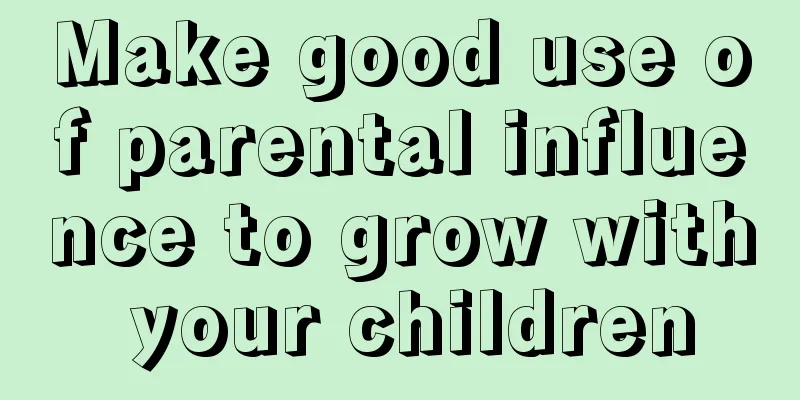How much milk does a baby eat in the first 3 days after birth?

|
For friends who have just become parents, they are very unfamiliar with the diet of newborn babies and cannot grasp the amount. So, how much milk should a baby drink in the first three days after birth? How much milk should the baby eat once every 3 days after birth?Generally, it is appropriate for a baby to drink 30 ml of milk every 3 days after birth. For newborn babies, mothers are advised to feed them on demand. When the baby is hungry and wants to drink milk, feed the baby. When the baby stops eating, it means he is full. Usually, newborns are fed about 10ml of milk each time on the first day; 15-20ml on the second day; 30ml on the third day, and you can add appropriate amount slowly thereafter. It is appropriate for a baby to feed about 8 to 12 times a day within 3 days after birth. The stomach capacity of a newborn baby is very small, only about 20-30ml, and the stomach empties very quickly, so the baby should be fed every 2-3 hours, about 8-12 times a day. It is best to ensure that the baby's total daily milk intake is 200-300ml. Mothers should be careful not to deliberately control the number and time of feeding the baby, which may easily cause the baby to be underfed. How long should the baby feed once every 3 days after birth?The baby will feed on one breast for about 10 minutes each time when he is 3 days old. The normal breastfeeding time for babies is 10 minutes on each breast, and 20 minutes on both sides is enough. However, the sucking ability of a baby who is just 3 days old is not very strong, and the mother's breasts may not be completely unobstructed, so the baby may feed for a longer time. If the baby is fed with milk powder, it is generally enough to drink about 30ml of milk powder in the bottle. Remark 1. How to speed up breastfeeding If a newborn baby falls asleep while eating or sucks the nipple instead of breastfeeding, you can stimulate the newborn baby to feed faster by gently rubbing his earlobes with your fingers, gently pulling his little fingers or toes, or trying to remove the nipple. 2. Quantity and duration of feeding If one breast is fed for 10 minutes, the newborn can eat 50% of the total milk in the first 2 minutes, 80%-90% of the total milk in the first 4 minutes, and almost no milk in the next 6 minutes. How to feed your baby correctly after 3 days1. Natural childbirth, episiotomy pain You can lie on your side with your baby facing you, resting his head on your arm so his mouth is level with your nipple. Use pillows to support your back. This is also a good position after a cesarean section. 2. Caesarean section, pain in lower abdominal wound You can place your baby on your side, with your forearm supporting his back and his neck and head resting on your hand. This is a good position if you are recovering from a cesarean section, as it puts less pressure on the wound. 3. Milk powder feeding Use the inside of your elbow to support your baby's head so that his waist is close to your body. Then put the bottle into the baby's mouth. Make sure the baby holds 2/3 of the nipple to avoid inhaling too much air, which may cause hiccups or spitting up. How to judge whether a 3-day-old baby is full1. See if the baby is crying A baby who is just 3 days old can only express whether he is hungry by crying, so we can judge whether the baby is full by looking at the baby's facial expression after feeding. If the baby is full, he will be satisfied and quiet between two feedings, and usually sleep for 3-4 hours. If he is not full, he will cry. 2. See if the baby opens his mouth to suck In addition, parents can also put their hands on the baby's mouth when feeding to see if the baby will open his mouth to drink milk and suck. If the baby opens his mouth and sucks your fingers, it means he is hungry. Otherwise, he is full! Remark It is not accurate to look at the bowel movements, weight, and number of breastfeedings, because the bowel movements of a baby who is just 3 days old have not yet formed a regular pattern, and the weight may be lower than the birth weight due to meconium and lack of water after birth. The number of breastfeedings cannot be considered as a hard and fast rule. Things to note when feeding your baby in the first 3 days1. Do not breastfeed while lying down, as this may cause the breast to press on the baby's mouth and nose, causing suffocation. 2. Burp your baby after feeding. After your baby finishes feeding, don't let him lie down immediately. Burping him can help him expel the air in his stomach to prevent him from vomiting milk. 3. To heat milk for your baby, it is best to soak it in hot water or use a special milk warmer to heat it. Try not to heat it in a microwave. 4. Do not breastfeed for too long. If you do, the newborn will inhale more air, which may cause vomiting, regurgitation, abdominal distension and other discomforts. 5. Mothers should not wait until the baby is very hungry or crying before feeding, as this may cause the baby to spit up milk. 6. Do not breastfeed your baby when you are angry (or just after being angry), as it may be harmful to the baby's health. Amount of milk for babies under one year old1. The first 5 days: Day 1: about 15 ml of colostrum each time; Day 2: about 20 ml each time; Day 3: about 30 ml each time; Day 4: about 45 ml each time; Day 5: about 70 ml each time. 2. The amount of milk for a one-month-old baby: Generally, feed 6-7 times a day, with an interval of 3.5-4 hours between each feeding. Each feeding should be about 80-120 ml, and the maximum amount can be 150 ml. 3. Milk intake for babies aged 2-3 months: 5-6 times a day, once every four hours, with 150-200 ml of milk each time. 4. Milk volume for babies aged 3-4 months: 5 times a day, once every four hours, with each feeding amount of 150-200 ml. 5. 5-6 months old baby milk volume: 4 times a day, eat 200-250 ml, the total amount of milk should be controlled, no more than 1000 ml per day, and no more than 250 ml per meal. Feed complementary food before feeding. 6. Milk intake for babies aged 6-9 months: Feed 3 times a day, once every four hours, 200-250 ml each time. Supplementary food starts from replacing half a meal to replacing one meal of milk. 7. Milk volume for babies aged 9-12 months: Feed twice a day, 250 ml each time, and still feed every four hours. Eat complementary food at other times. |
<<: What to do if your baby has diarrhea 10 days after birth? 8 ways to avoid medication
>>: Can you touch a newborn's head? It is not recommended.
Recommend
How to relieve the pain of teething baby and crying
When babies are 3 or 4 months old, their teeth wi...
Does hair dyeing affect pregnancy? What effects does hair dyeing have on pregnant women?
I believe everyone is also aware that hair dyes c...
Can washing your face with toothpaste remove spots and whiten your skin? Does washing your face with toothpaste hurt your skin?
We all know that toothpaste is used for brushing ...
How long does it take for the belly to become flat again after giving birth? How long does it take for the belly to shrink after giving birth?
After pregnancy, the belly of a pregnant woman wi...
Are scented candles harmful to the human body? Can scented candles be lit overnight?
Scented candles are a product that we are all fam...
Do babies need pillows? At what age can babies use pillows?
At what age can babies use pillows? Adults cannot...
Can you get pregnant with a small amount of menstrual flow? The key is whether you can ovulate
Infrequent menstruation is a very common disease....
How long does it take to deliver? What should I prepare for delivery?
Mothers whose due date is approaching can prepare...
What should be paid attention to after the baby is scalded? How to repair the baby's scald scar
In daily life, babies may be scalded by boiling w...
The pros and cons of painless childbirth What is painless childbirth?
Many mothers are afraid of the moment of giving b...
What to do with baby's dry cough and what to eat to get better quickly
There are many reasons for dry cough, but for you...
Can pregnant women drink Isatis root when they have a cold? Pregnant women should be cautious when taking medicine
Whether pregnant women can drink Isatis root when...
What are the conditions for IVF? Who is suitable for IVF?
IVF is a medical method for infertile couples. It...
How to train your baby to fall asleep on his own? How to train your baby to sleep through the night?
The baby's sleep problems will determine the ...
Will eating pork belly make childbirth smoother? How to make childbirth smoother
A smooth delivery helps the mother recover after ...









